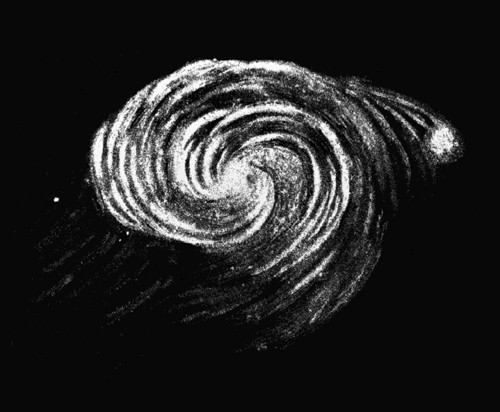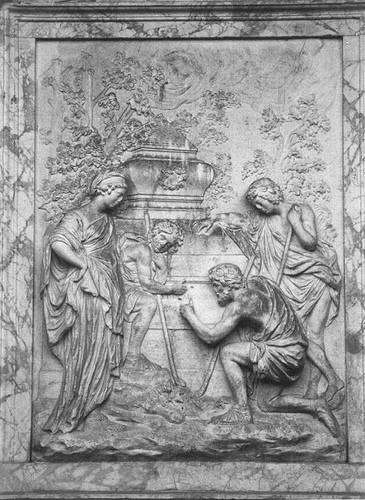knipperdollin
n. a fanatical idiot
“Toad Embedded in a Tree”
A few days ago, as two sawyers were employed in cutting up an oak tree about thirteen inches in diameter, for the use of the Earl of Derby’s colliery, at Rainsford, in Lancashire, the man in the pit perceived something to move in the part they were then cutting, which, on examination, proved to be a full-grown toad. The animal was quite alive, when taken up, notwithstanding one of the legs had been cut off by the saw; the cavity in which it was found was exactly in the centre of the tree, just large enough to contain the body, and measured three and a half yards from the root or bottom. The tree was perfectly sound in every part, and not the least crack or aperture could be discovered that had a communication with the atmosphere.
— La Belle Assemblée, January 1810
All Art Is Theft

Irish astronomer William Parsons might have been surprised to see van Gogh’s The Starry Night appear in 1889.
He had drawn this sketch of the Whirlpool Galaxy 44 years earlier:

Helen Duncan

In November 1941 a U-boat torpedoed the British battleship Barham, but the Germans didn’t realize they’d hit it. The British Admiralty managed to keep the loss a secret for two months, but in the interval a Scottish spiritualist named Helen Duncan announced that the Barham had sunk. She said she’d heard the news from a dead sailor.
The British authorities arrested Duncan, hoping to discredit her story. They appealed to an old law against fraudulent “spiritual” activity … which unfortunately was called the British Witchcraft Act of 1735.
So: History records that a practicing medium who revealed an “unknowable” secret at a séance in 1941 was convicted under a witchcraft law. She served 9 months.
Racing by Starlight
Now You See Him …
Teleportation in the Bible:
And he commanded the chariot to stand still [in Gaza]: and they went down both into the water, both Philip [the Evangelist] and the eunuch; and he baptized him. And when they were come up out of the water, the Spirit of the Lord caught away Philip, that the eunuch saw him no more: and he went on his way rejoicing. But Philip was found at Azotus: and passing through he preached in all the cities, till he came to Caesarea.
(From Acts 8:38-40.)
Pop Quiz
When calculating prodigy Truman Henry Safford was 10 years old, the Rev. H.W. Adams asked him to square the number 365,365,365,365,365,365 in his head. Dr. Adams wrote:
He flew around the room like a top, pulled his pantaloons over the tops of his boots, bit his hands, rolled his eyes in their sockets, sometimes smiling and talking, and then seeming to be in agony, until in not more than a minute said he, 133,491,850,208,566,925,016,658,299,941,583,225!
Safford (1836-1901) went to Harvard and became director of the Hopkins Observatory at Williams College. Strangely, his calculating abilities seemed to wane as he got older.
The Shugborough House Inscription

This relief appears on an 18th-century monument on the grounds of Shugborough Hall, a country estate in Staffordshire, England. The shepherds are pointing to this inscription:
O•U•O•S•V•A•V•V
D• M•
What does it mean? No one knows. If it’s a ciphertext, no one’s been able to solve it, and that includes the codebreakers at Bletchley Park, who cracked the German Enigma code in World War II.
If you can decipher it, there may be a reward in it for you: Some say the message contains a clue to the location of the Holy Grail.
Modern Girl
When Cleopatra was born, the Great Pyramid was already 2,500 years old.
“A Shocking Discovery”
It is well known that during the French Revolution, the wood Kusel, near Deux Ponts, was often the scene of various actions, and that the Prussians encamped in it a considerable time; consequently the wood was so nearly ruined, that only a few oak trees were left standing here and there. These trees were sold in the month of March last, 1803, and one lot fell to a citizen of Strasburgh for fifty florins. Soon afterwards ordering two of them to be cut down, one of them, the largest, was no sooner divided for the purpose of removal, than to the astonishment of the labourers they discovered a human skeleton, from which all the flesh having wasted away, nothing remained near the body at the bottom of the tree but some bits of blue cloth, and part of a hat. A purse half decayed was also found, containing about 100 louis d’ors in gold; and from the buttons upon the blue cloth, it was concluded that the deceased had been a Prussian officer, who not knowing the tree to be hollow, was probably sleeping near the top of the trunk of it, had slipped in, and from cold, or a variety of circumstances, being unable to extricate himself, had there perished. The fact, however, can be attested by the proprietor, the purchaser of the trees, and several other persons.
— Kirby’s Wonderful and Scientific Museum, 1803

